

|
UV click Released

Design devices that warn you of excesive ultraviolet radiation levels with UV click. This click boards carries the ML8511 IC that is sensitive to UV-A (365-315 nm) and UV-B (315-280 nm) rays. The board can output either analog or digital signals proportional to the amount of UV exposure. To bypass the onboard MCP3201 ADC and get an analog output, solder the A/D SEL jumper in the AN position. Depending on the position of the jumper, UV click communicates with the target board either through mikroBUS SPI (CS, SCK, MISO) or AN lines; additionally, the sensor can be enabled or disabled from the MCU through the RST (EN) pin. When handling UV click, be careful not to press or rub the sensitive surface of the ML8511 sensor IC. UV click uses a 3.3V power supply only.
|
2014/08/28 |


|
Motion click (PIR) Released

MOTION click is a motion detector sensitive only to live bodies. It carries PIR500B, a pyroelectric sensor which generates a voltage when exposed to infrared light. The signal is processed by a BIS0001 PIR sensor controller which sends an interrupt to the MCU through the mikroBUS INT (out) line. An onboard potentiometer lets you adjust the detecting range of the sensor (up to 4 meters). MOTION click also has a night only mode—resoldering a zero-ohm jumper activates the onboard photo resistor which acts as a light-sensitive switch. You can also switch the sensor ON and OFF by sending a signal from the MCU through the mikroBUS RST pin. The board uses a 3.3V power supply only.
|
2014/08/27 |


|
LIN Hall click Released

LIN HALL click carries an MLX90242 linear Hall sensor IC (with built-in active error correction circuitry) and an MCP3201 12-bit ADC. It outputs a signal that is proportional to the flux density of a magnetic field - a north magnetic field will increase the output value while a south magnetic field will cause it to decrease. The ratiometric output allows you to infer the linear or rotary position of a target object by placing magnets on it. LIN HALL click communicates with the target board through the mikroBUS SPI lines (CS, CSK, MISO). The board is designed to use either a 3.3V or a 5V power supply.
|
2014/08/25 |

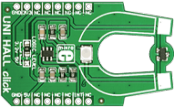
|
UNI Hall click Released

UNI HALL click is a simple solution for adding an unipolar Hall switch to your design. It carries the Melexis US5881 unipolar Hall-effect switch and a 74LVC1T45 single bit, dual supply translating transceiver. The unipolar Hall effect sensor on UNI HALL click is sensitive to north pole magnetic fields - when exposed to such a field, it outputs a LOW logic level. Otherwise the output is a HIGH logic level. It can be employed in a wide variety of scenarios - anywhere where a magnet can be used to infer speed, position, or other properties of the target object. UNI HALL click communicates with the target board through the mikroBUS INT line. It's designed to use either a 3.3V or a 5V power supply.
|
2014/08/25 |

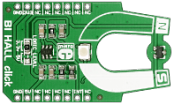
|
BI Hall click Released

Bi Hall click is a simple solution for adding a bipolar Hall switch to your design. It carries the Melexis US2882 bipolar Hall-effect switch and a 74LVC1T45 single bit, dual supply transceiver. A bipolar Hall effect sensor is sensitive to both north and south pole magnetic fields. Bi Hall click outputs a HIGH logic level when exposed to a south pole magnetic field, and a LOW logic level when exposed to a north pole magnetic field. When removed from a magnetic field, the logic level stays in its previous state. The US2882 IC integrates a Schmitt trigger with hysteresis, thus preventing output oscillation near the switching point between alternating magnetic poles. Bi Hall click communicates with the target board through the mikroBUS INT line. It's designed to use either a 3.3V or a 5V power supply.
|
2014/08/21 |


|
LDC1000 click (Inductance Measurement) Released

The LDC1000 click board carries the world's first inductance-to-digital converter IC, along with a detachable sensor (an LC tank comprising a 36-turn PCB coil and a 100pF 1% NPO capacitor). The LDC1000 IC has a sub-micron resolution in short range applications; the board is ideal for highly precise short range measurements of the position, motion or composition of conductive targets. Inductive sensing is highly reliable: harsh conditions don't hinder the performance of LDC1000 IC. Onboard INA and INB pins allow you to replace the provided detachable sensor and solder your own. LDC1000 click communicates with the target board through mikroBUS SPI (CS, SCK, MISO, MOSI) and INT lines. The board is designed to use either a 3.3V or a 5V power supply.
|
2014/08/13 |


|
Hydrogen click Released

Hydrogen click carries an MQ-8 sensor for hydrogen (H2). The gas sensing layer on the sensor unit is made of tin dioxide (SnO2), which has lower conductivity in clean air. The conductivity increases as the levels of hydrogen rise. The detection range of the sensor is 100-10000ppm of hydrogen. To calibrate the sensor for the environment you’ll be using it in, Hydrogen click has a small potentiometer that allows you to adjust the load resistance of the sensor circuit. For precise calibration the sensor needs to preheat (once powered up, it takes over 24h to reach the right temperature). Hydrogen click communicates with the target board through AN (OUT) mikroBUS line. It's designed to use a 5V power supply only.
|
2014/08/11 |


|
BLE P click (BlueTooth) Released

BLE P click carries an nRF8001 IC for adding a Bluetooth 4.0 (alternatively known as Bluetooth Low Energy) peripheral device to your design. BLE is an essential feature of today's "smart" gadgets. Its low energy consumption makes it ideal for sport and fitness devices, proximity sensors, smart watches and so forth. Newer smartphones, tablets and computers have hardware and software support for BLE. To get you started with BLE P click, an open-source BLE Android app is available (works on devices with hardware and software support for BLE). BLE P click communicates with the target board MCU through mikroBUS SPI (CS, SCK, MISO, MOSI), RDY and ACT lines. It uses a 3.3 V power supply only.
|
2014/08/06 |

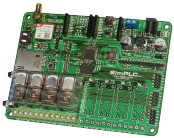
|
SimPLCv2 available on pre-release!

Our new SimPLCv2 board offers a number of new features, improvements and tweaks over the original SimPLC; including an improved power supply, new SIM800H GSM/GPRS module which also features BlueTooth and an FM Radio, backup battery for the SIM800H's RTCC (real-time calendar and clock), and an LCD connector for Alphanumeric LCDs.
|
2014/07/31 |

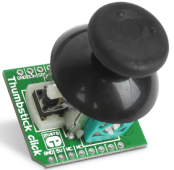
|
Thumbstick click Released

Thumbstick click is a high precision input device. It features a dual axis, spring return, pushbutton enabled joystick (similar to the ones used on joypads on popular gaming consoles), and a MCP3204 12-bit A/D converter. The joystick unit receives directional input in the x and y axes by way of two potentiometers connected to a stick. The mechanical pushbutton sends an interrupt signal to the microcontroller. Thumbstick click communicates with the target board through mikroBUS SPI (CS, SCK, MISO and MOSI) lines. The board is designed to use either a 3.3V or a 5V power supply (regulated by the on-board J1 jumper which is soldered to the 3.3V position by default).
|
2014/07/28 |

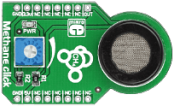
|
Methane click Released

Methane click carries an MQ-4 sensor for methane (CH4). The gas sensing layer on the sensor unit is made of tin dioxide (SnO2), which has lower conductivity in clean air. The conductivity increases as the levels of methane rise. The detection range of the sensor is 200-10000ppm of methane. To calibrate the sensor for the environment you'll be using it in, Methane click has a small potentiometer that allows you to adjust the load resistance of the sensor circuit. For precise calibration the sensor needs to preheat (once powered up, it takes 24h to reach the right temperature). Methane click communicates with the target board through AN (OUT) mikroBUS line. The board is designed to use a 5V power supply only
|
2014/07/28 |


|
LPG click Released

LPG click carries an MQ-5 sensor for detecting liquefied petroleum gas leakage. The gas sensing layer on the sensor unit is made of Tin dioxide (SnO2), which has lower conductivity in clean air. The conductivity increases as the levels of LPG rise. The detection range of the sensor is 200-10000 ppm of LPG. To calibrate the sensor for the environment you'll be using it in, LPG click has a small potentiometer that allows you to adjust the Load Resistance of the sensor circuit. For precise calibration the sensor needs to preheat (once powered up, it takes 24h to reach the right temperature). LPG click communicates with the target board through AN (OUT) mikroBUS line. The board is designed to use a 5V power supply only.
|
2014/07/28 |

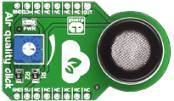
|
Air Quality click Released

Air quality click carries an MQ-135 sensor for detecting poisonous gases that impact air quality in homes and offices. The gas sensing layer on the sensor unit is made of tin dioxide (SnO2), which has lower conductivity in clean air. The conductivity increases with air pollution. The sensor reacts to ammonia (NH3), nitrogen oxides (NOx), benzene, smoke, CO2 and other harmful gases. To calibrate the sensor for the environment you'll be using it in, Air quality click has a small potentiometer that allows you to adjust the load resistance of the sensor circuit. Air quality click communicates with the target board through AN (OUT) mikroBUS line. The board is designed to use a 5V power supply only.
|
2014/07/28 |


|
Hall Current click Released

Hall current click is a high precision current sensor. It carries a galvanically isolated TLI4970-D050T4 miniature magnetic digital current sensor that utilizes the Hall effect to measure electric current. It can detect current levels from -49 to +49 amps, both AC and DC. The board carries two EXTreme ZPower connectors (IP- and IP+) to connect the conductor. The current rail is galvanically isolated from the interface to the microcontroller. The sensor readings are sent to the target board through the mikroBUS SPI (SDO, SCK, and CS) lines. The board uses a 3.3V power supply only.
Hall current click can be used with dangerous voltage levels. Use caution when working with current and the Hall current click - DO NOT TOUCH THE BOARD WHILE THE EXTERNAL POWER SUPPLY IS ON!
|
2014/07/14 |


|
Mini-M4 for Tiva C Series Released

MINI-M4 for Tiva C Series is a small ARM Cortex-M4 development board containing Tiva C Series TM4C123GH6PM microcontroller. It perfectly fits into a standard DIP40 socket. The board is equipped with a 16MHz SMD crystal oscillator, and a 32.768KHz crystal which can be used for the internal hibernation module. It has a reset button and three signal LEDs. The board comes preprogrammed with a fast USB HID bootloader, so no external programmers are needed for development. It operates on a 3.3V power supply. An on-board voltage regulator allows the board to be powered directly from a USB cable.
|
2014/07/14 |

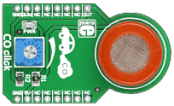
|
CO click Released

CO click carries an MQ-7 sensor for Carbon monoxide. The gas sensing layer on the sensor unit is made of Tin dioxide (SnO2), which has lower conductivity in clean air. The conductivity increases as the levels of Carbon monoxide rise. The detection range of the sensor is 20ppm-2000ppm of CO. To calibrate the sensor for the environment you’ll be using it in, CO click has a small potentiometer that allows you to adjust the Load Resistance of the sensor circuit. For precise calibration the sensor needs to preheat (once powered up, it takes 48h to reach the right temperature). CO click communicates with the target board through AN (OUT) mikroBUS line. The board is designed to use a 5V power supply only.
|
2014/07/09 |

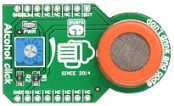
|
Alcohol click Released

Alcohol click carries an MQ-3 Semiconductor sensor for alcohol. The gas sensing layer on the sensor unit is made of Tin dioxide (SnO2), an inorganic compound which has lower conductivity in clean air. The conductivity increases as the levels of alcohol gas rise. Alcohol click has a high sensitivity to alcohol and it can be used to detect alcohol in concentrations from 0.04 to 4mg/l. To calibrate the sensor for the environment you’ll be using it in, Alcohol click has a small potentiometer that allows you to adjust the Load Resistance of the sensor circuit. Alcohol click communicates with the target board through AN (OUT) mikroBUS line. The board is designed to use a 5V power supply only.
|
2014/07/09 |

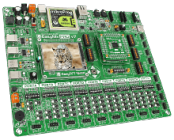
|
EasyMxPROv7 for TIVA ARM Released

EasyMx PRO v7 for Tiva C Series is a development board for TI's Tiva Cortex-M4 devices. It contains many on-board modules necessary for device development as well as a hardware debugger.
|
2014/07/09 |

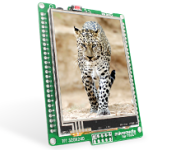
|
mikroMedia for Tiva C Series Released

Compact multimedia development platform for TI's Tiva C Series TM4C123GH6PZ ARM Cortex-M4 microcontroller.
|
2014/06/27 |


|
HTerm - The UART Terminal You've Always Wanted

HTerm is by far the most feature-rich UART (RS232) terminal we have yet seen. Amongst other things, it facilitates sending, receiving and display of data in ASCII, Hex, Decimal and Binary formats - simultaneously. If you are a developer who uses UART communication in your projects, then we highly recommend that you take a look at it.
|
2014/06/27 |

|

